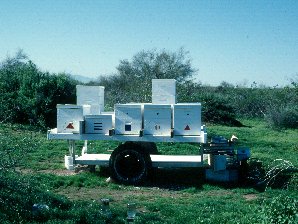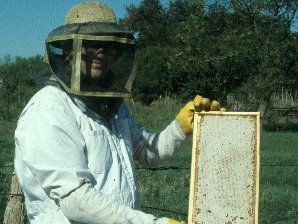Arizona Desert Environment.
( Non - Xeriscape. )
Common Landscape Plants. Shrubs, Flowers, & Trees.
For The Arizona Desert Environment
Pictures, Photos, Images, Descriptions, & Reviews.
George & Eve Delange

|
All Links Below ( With An * ) Lead To Thumbnails.
Click On A Thumbnail To Bring Up An Active Page.
Note: These Plants Grow Well In Arizona,
But They Require More Water Than Xeriscape Plants.
We Recommend That You Look At Our Xeriscape Plant Web Page
& Consider Using Xeriscape Plants such as,
Saguaro Cactus, Cereus giganteus, shown below.
Click On A Thumbnail To Bring Up An Active Page.
Note: These Plants Grow Well In Arizona,
But They Require More Water Than Xeriscape Plants.
We Recommend That You Look At Our Xeriscape Plant Web Page
& Consider Using Xeriscape Plants such as,
Saguaro Cactus, Cereus giganteus, shown below.
Insecticides, Fungusides, & Sprayers
Sold Through Amazon.Com That We Can Recommend,
Click On The Item For A More Detailed Look. No Obligation!



In many cases, the landscaping plants used in Arizona are not low water use, or Xeriscape. Therefore we are listing some of the more common non xeriscape plants on this page. While non xeriscape was common during the early history of Arizona during the 1800's to the mid 1900's it is not used too often today in an attempt to conserve water. The following information is a brief description of our experience.
George and his friend Al Weichold, kept honey bees in the Phoenix, Arizona area from about 1966 to about 1992. During that time they learned a lot about how to produce honey in Arizona. One of the secrets of producing honey was to follow the "honeyflow" which is the opening of the flowers that produced the nectar that the bees turned into honey. Thus, George and Al had to know the flowering plants of Arizona and when the flowering plants would bloom. They also had to know which plants would not produce honey. George also taught High School Life Science and Environmental Science from 1983 until 2003 in the Phoenix Area. Part of his class that he taught was the "Merriam Life Zones Of Arizona" in which the living organisms in the areas are determined by the factors of temperature and available water which are also influenced by the various elevations found within the State Of Arizona. In 1889 C. Hart Merriam studied the distribution patterns of plants and animals in a broad swathe from the lower elevations of the Grand Canyon to the top of Humphreys Peak (elevation 12, 760 ft) in the San Francisco Mountains near Flagstaff, Arizona. Based on his observations in the field, Merriam developed the concept of a Life Zone, a belt of vegetation and animal life that is similarly expressed with increases in altitude and increases in latitude. These Life Zones (sometimes called "Vegetative Communities") are unique groupings of plants and animals based on elevation. These communities take into account the fact that for every 1000 feet gain in elevation the temperature drops 3 degrees F and the precipitation increases as well. The plants and animals you'll likely encounter in the life zone depends upon the varying elevations as you climb up a mountain or "sky island" in Arizona such as the Santa Catalina Mountains. Keep in mind that what you will see when you visit each vegetative community is dependent on the season of the year and the amount of precipitation for that year. Over the years Merriam's Life Zones have been changed and modified as new information has been researched and revealed. But, they are basically the same as when Merriam did his original work on the subject. George will present on the following pages what he has learned about flowering plants in Arizona as a Beekeeper and Life Science Instructor. No attempt is being made here to present a detailed scientific page on the subject. Every plant in Arizona will not be shown. George hopes that these pages might be simply of interest to anyone who wants to learn about the beautiful wildflowers and plants of Arizona. Over the past fifty years Phoenix has became less agricultural and more urban. Therefore some of the photos on this page will also show how native plants and some not so native plants are used in todays Xeriscape (low water use) landscaping in Arizona. It may be of interest to know that many of the non native plants that are growing in Arizona were introduced from Australia. George still spends the winters in the Glendale area, in an urban neighborhood about a quarter mile from where he kept his bees. George never thought that population changes would have effected the Glendale and Peoria area as much as it has done! Glendale and Peoria have certainly grown. People now are afraid of Honeybees. Laws have been passed outlawing beekeeping in urban areas. Good News ! George has started up keeping bees again. He hopes to have some fresh honey soon! Eve DeLange also is very interested in keeping bees. George calls Eve, the "Queen Bee !" George often wonders; since bees are absolutely necessary for much of our food production, what will be our future without bees? Another practice that he wonders about is that over the 68 years he has lived in the Greater Phoenix Area, almost all of the very rich agricultural land has been covered with cement and buildings as the area has grown. Where will our food come from? And, do we have enough water to continue building lakes, swimming pools, golf courses, and landscaping on our urban areas the way that we are now doing? Even though the winter of 2004, the spring of 2005, and Jaunary of 2010 have been some of the wettest seasons we have ever had in our recorded history, we are still considered to be in a time of drought! George hopes it will all work out. Only time will tell!
|
THE 2017 WILDFLOWER PREDICION:
|
Arizona has two major wildflower seasons every year; with the Spring Wildflower Season usually during March to May, and the Summer Wildflower Season from July through September. Then there is a blooming season for a few flowers, during the fall. However, some wildflowers can usually be found at other times of the year . Depending upon local temperatures. Rainfall has a lot to do with our wildflower season. In the Phoenix area, the driest weather is during May & June when an average of about 3 mm (0.1 in) of rainfall (precipitation) occurrs. The abundance of wild flowers in the deserts of Arizona, in the spring, is largely determined by the amount of rainfall during the winter of the prior year and the early spring of the present year.
The National Oceanic Atmospheric Administration (NOAA) has released their winter outlook for the months of December, January and February of 2017.
The National Oceanic Atmospheric Administration (NOAA) creates forecasts of weather patterns, based on various models. On October 20, 2016; forecasters at NOAA�s Climate Prediction Center issued the U.S. Winter Outlook, saying that La Nina is expected to influence winter conditions this year. The Climate Prediction Center issued a La Nina watch in October, predicting the climate phenomenon is likely to develop in late fall or early winter. La Nina favors drier, warmer winters in the southern U.S and wetter, cooler conditions in the northern U.S. If La Nina conditions materialize, forecasters say it should be weak and potentially short-lived. George DeLange says, "as of today, December 21, 2016; these predictions seem to be holding out."
The rainfall in Arizona is very much affected by a band of warm ocean water that develops in the central and east-central equatorial Pacific (between approximately the International Date Line and 120�W), including off the Pacific coast of South America.
Another aspect of El Ni�o; called the El Ni�o Southern Oscillation, refers to the cycle of warm and cold temperatures, as measured by sea surface temperature, SST, of the tropical central and eastern Pacific Ocean. El Ni�o is accompanied by high air pressure in the western Pacific and low air pressure in the eastern Pacific.
The cool phase of ENSO is called "La Ni�a" with SST in the eastern Pacific below average and air pressures high in the eastern and low in western Pacific. The ENSO cycle, both El Ni�o and La Ni�a, causes global changes of both temperatures and rainfall
According to AccuWeather Senior Meteorologist Brett Anderson; This winter's El Ni�o could be one of the strongest in the past 50 years. He says, "El Ni�o has steadily strengthened over the past month and is now approaching strong category strength."
Anderson said. "El Ni�o typically reaches its peak during the December through February period."
THE OLD FARMER'S ALMANAC PREDICTIONS, for the time period of November 2016 to October 2017 are:
"Winter will be warmer and drier than normal, with below-normal snowfall. The snowiest periods will be in early and late December and mid- to late January.
The coldest periods will be in early and late December and from late January into early February.
April and May will be slightly rainier than normal, with below-normal temperatures."
Summer will be slightly cooler and rainier than normal.
The hottest periods will be in mid- to late June and early and mid- to late July.
September and October will be cooler and rainier than normal."
George says, "as of today, December 21, 2017; these predictions seem to be holding out."
We will have a Below Average Blooming Season!
George was going to predict an average blooming season, but we have not had the amount of rain in the fall of 2016 that he expected so George thinks it will be below average.
In the spring of 2017 we will be able to see examples of some of Arizona's Wildflowers!
To make this prediction, George has examined the other weather data & predictions mentioned above. He also has taken into consideration the rainfall of Arizona during the fall & winter of 2016.
|
The following cities and organizations in the Valley Of The Sun or Phoenix Metropolitan Area are supporting Xeriscape (low water use) Landscaping and offer advice, booklets, and cash incentives worth several hundred dollars. Chandler; 480-782-3580, Gilbert; 480-503-6098, Glendale; 623-930-3596, Goodyear; 623-932-1637, Mesa; 480-644-3306, Peoria; 623-773-7286, Phoenix; 602-261-8367, Scottsdale; 480-312-5650, Tempe; 480-350-2668, Arizona Municipal Water Users Association; 602-248-8482.
|
| © 1966 - Present, George & Eve DeLange |
We're Glad You Stopped By! Come back soon!
All Of Our Images Are Copyrighted. They May Not Be Used Without Permission.
The Low Resolution Photos That Can Be Downloaded From Our Pages Are Available, Free Of Charge, Upon Request:
To Students, & Teachers For Classroom Use
Any Other Use Is Considered Commercial.
Almost All Of Our Photos (NOT ALL) Are Available In High Resolution, For Commercial Use (Books, Magazines, TV Productions, etc.)
They Are Royalty Free, And A One Time, $30 US Fee Is Charged For Each Photo
We Are Proud Of Our SafeSurf Rating!
 |  |
| Click On This Photo Of George's Old Bee Trailer With Bees! For George's Beekeeping Page | Click On This Photo Of George Showing Off His Pure Mesquite Comb Honey!! For George's Beekeeping Page |
|---|
Click On The Item For A More Detailed Look. No Obligation!







